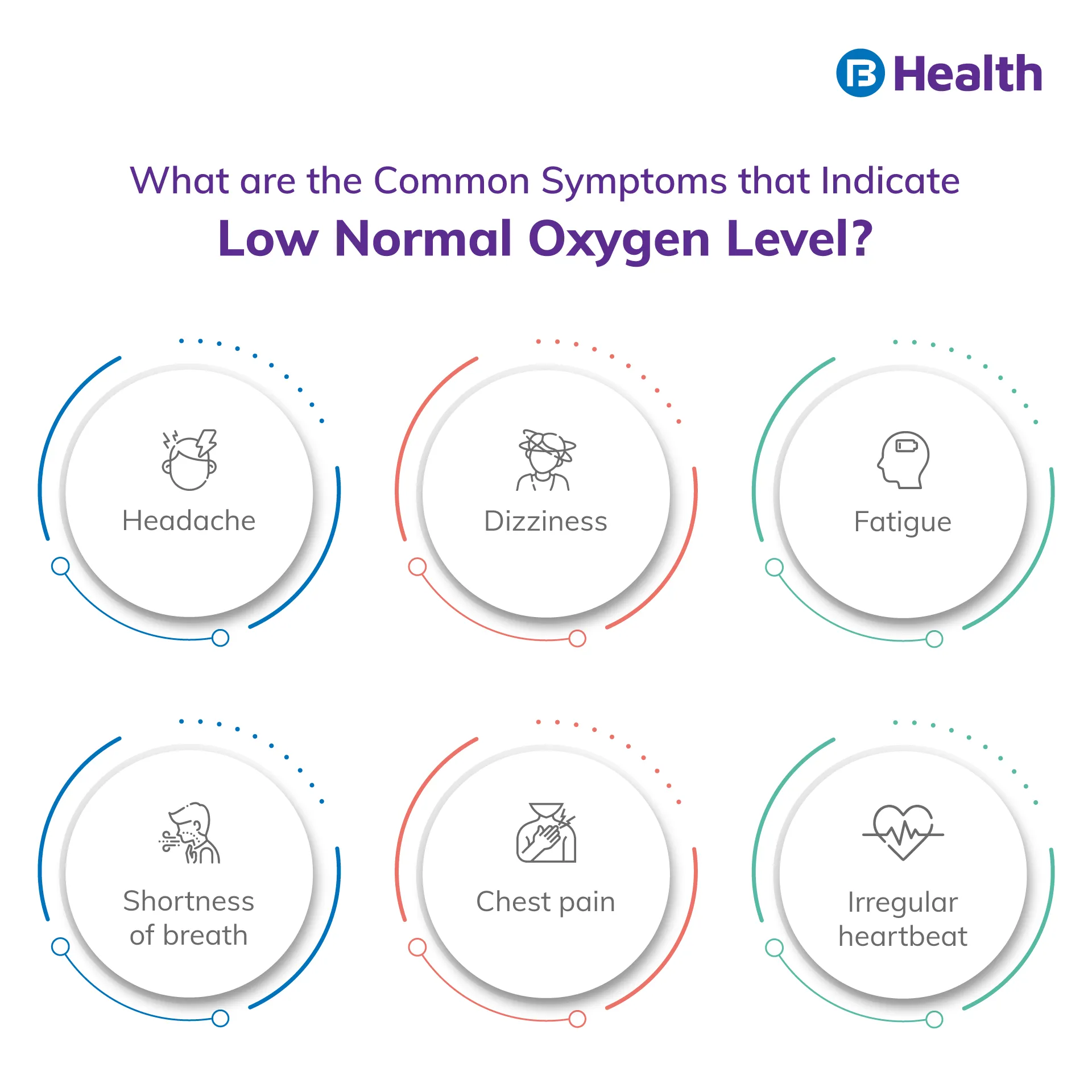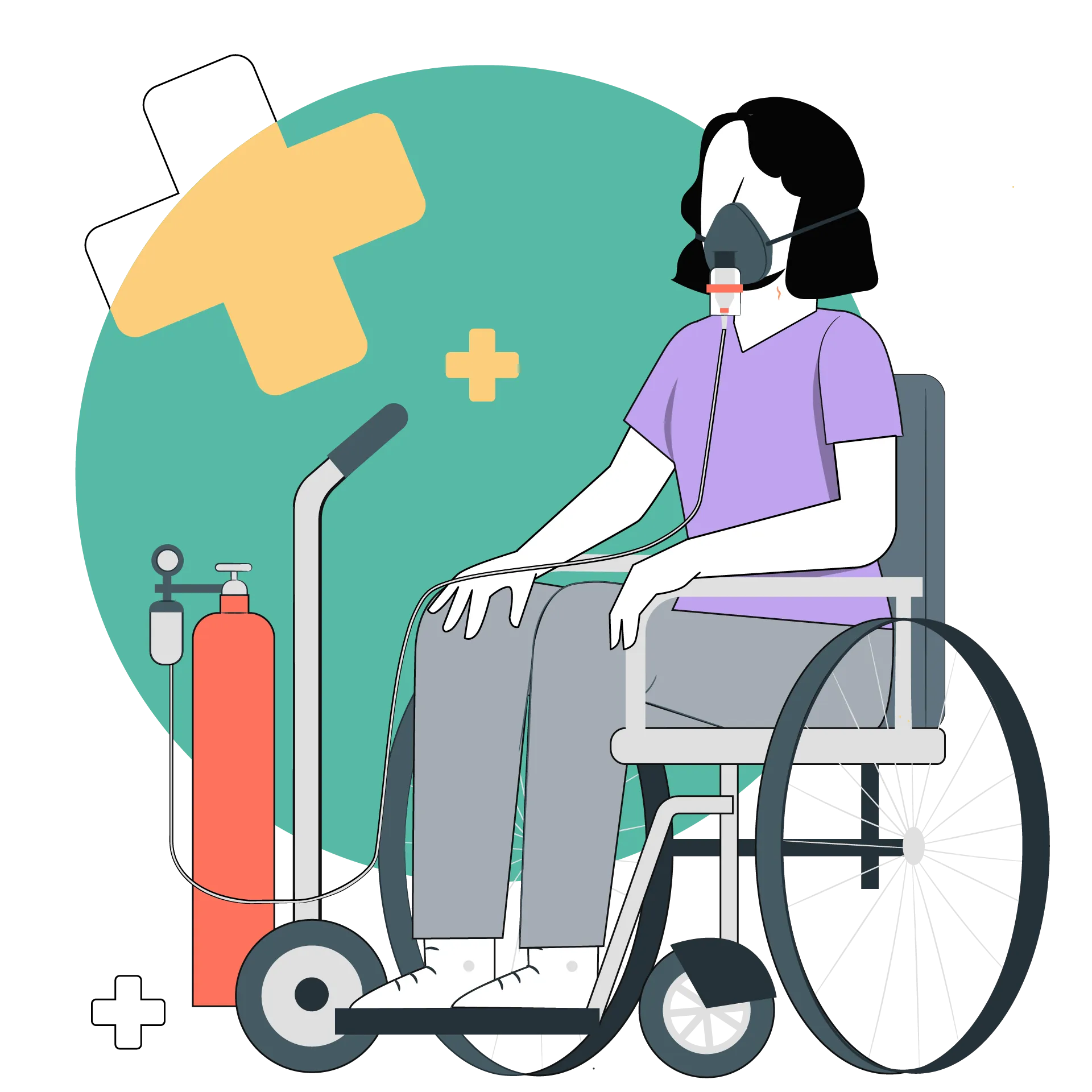General Physician | 7 min read
Normal Oxygen Level: Causes, Symptoms and Prevention
Medically reviewed by
Table of Content
Synopsis
The term 'normal,' when applied to oxygen saturation level (SpO2), refers to the average or healthy level of oxygen in the blood. Normal oxygen saturation levels range from 95 to 100 percent for most people. However, some people may have oxygen saturation levels lower than 95 percent due to certain medical conditions.
Key Takeaways
- A normal oxygen level means the lungs are functioning properly and delivering oxygen to the blood
- Normal oxygen saturation levels range from 95 to 100 percent
- A low oxygen level can be indicative of a problem with the lungs or respiratory system
What are Blood Oxygen Levels?
Blood oxygen levels measure the amount of oxygen in your blood. Monitoring the normal oxygen level is important because it is essential for the body to function properly. Lower oxygen levels can lead to serious health problems, so it's important to keep an eye on them. There are a few different ways to measure blood oxygen levels. The most common method is through a pulse oximeter, which is a small device that is placed on the finger.
A pulse oximeter measures the oxygen levels in the blood by shining a light through the skin. A blood test can be used to measure the normal oxygen level. This way of measuring blood oxygen levels is typically done if there are concerns about low oxygen levels or someone with a lung condition. Keeping track of your blood oxygen levels to maintain a normal oxygen level is important for your overall health. If you have any concerns, be sure to speak with your doctor.
How is Blood Oxygen Level Measured?
There are two ways to measure your oxygen level. One is through a pulse oximeter, a handheld device, and the other is through a blood test.
Pulse oximetry is the most common method of blood oxygen measurement. A pulse oximeter uses a small sensor that emits light. Blood absorbs the light, and the amount of absorption is used to calculate the oxygen level.
Blood tests are used when pulse oximetry is not possible or when more accurate measurements are needed. In a blood test, a sample of your blood is taken and then analysed in a lab. Blood test results are more accurate than a pulse oximeter.
What is The Ideal Blood Oxygen Level?
The normal oxygen level in the human body is approximately 98.6%. [1] However, this number can vary depending on a person's age, activity level, and overall health. For example, newborns typically have higher oxygen levels than adults, and people who live at high altitudes may have lower oxygen levels than those who live at lower altitudes.
While the oxygen level in the human body is generally stable, several factors can cause it to fluctuate. Illness, injury, and certain medical conditions can all lead to changes in a person's oxygen level. It is important to monitor your oxygen level and maintain a oxygen level if you have any concerns about your health.

What is the average oxygen level?
The average oxygen level for humans is 95 - 100 percent. However, this number can vary depending on a person's age, health, and activity level. For example, newborn babies typically have an oxygen level of about 95 - 100 percent, while elderly adults may have a normal oxygen level of only 95 percent.
What is the normal oxygen level in the human body?
The average oxygen level in the human body is approximately 98.6%. However, this number can vary depending on a person's age, activity level, and overall health. For example, newborns typically have higher oxygen levels than adults, and people who live at high altitudes may have lower oxygen levels than those who live at lower altitudes.
Illness, injury, and certain medical conditions can all lead to changes in a person's oxygen level. It is important to monitor your oxygen level if you have any concerns about your health.
What Happens if Your Blood Oxygen Level is Too Low?
When your blood oxygen level is too low, your body will not get enough oxygen. The low blood oxygen level can be extremely dangerous and even life-threatening. If you think you may be experiencing symptoms of low blood oxygen, you should seek medical attention immediately.
Low blood oxygen can lead to organ damage, coma, and even death if not treated quickly. If you think you may be experiencing any of these symptoms, you should seek medical attention immediately.
Additional Read: Iron Test: Results, and Normal RangesWhat Causes Blood Oxygen Levels to be Low?
Every individual must maintain the oxygen level in the human body, but there are many different causes of low blood oxygen levels. The most common include heart disease, lung disease, and sleep apnea which can lead to several health problems, including shortness of breath, fatigue, and an increased risk of heart disease and stroke.
If you think you may have a problem with low blood oxygen levels, it's important to see a doctor. They can run tests to check your normal blood oxygen level and help you find the cause of the problem. Then, you can work on finding a treatment that will help you get your oxygen levels back to normal.
What Causes Low Oxygen Levels?
One of the most common causes of low oxygen levels is obstructive sleep apnea. These pauses can last for a few seconds to a few minutes and happen multiple times throughout the night. As a result, sleep apnea can cause low oxygen levels in the blood.
Other causes of low oxygen levels include COPD, heart failure, and anemia. Heart failure is a condition that makes it hard for the heart to pump blood.
Additional Read: What is hemoglobin test
Symptoms of Low Oxygen Levels
The human body requires a certain oxygen level in the blood to function properly. If the oxygen level is too low, it can lead to several health problems.
Some of the most common symptoms of low oxygen levels include:
- Shortness of breath
- Dizziness
- Headache
- Fatigue
- Irregular heartbeat
- Chest pain
Low oxygen levels can signify a serious health problem and should not be ignored.
Treatments for Low Oxygen Levels
There are a variety of treatments available for low oxygen levels. These treatments can be divided into two main categories - supplemental oxygen therapy and lifestyle changes.
Supplemental oxygen therapy is the most common treatment for low oxygen levels. This therapy involves using a device to deliver oxygen to the lungs. The oxygen level in the blood is monitored constantly, and the amount of oxygen delivered is adjusted accordingly. Lifestyle changes are another treatment option for low oxygen levels. These changes can include quitting smoking, exercising regularly, and avoiding high altitudes.
The best treatment for low oxygen levels depends on the condition's underlying cause. For example, supplemental oxygen therapy is often the most effective treatment for chronic lung conditions, while lifestyle changes may be more effective for heart conditions.
How to Prevent Low Oxygen Levels
Low oxygen levels can be dangerous and even life-threatening. That's why it's essential to know how to prevent low oxygen levels. There are a few things you can do to help keep your oxygen levels up:
Get regular exercise:
Exercise helps improve your respiratory system and can help keep your oxygen levels up
Avoid smoking:
Smoking damages your lungs and makes it harder for your body to get the oxygen it needs
Eat a healthy diet:
Eating a healthy diet helps your body to function at its best and can help improve your oxygen levels
Get plenty of rest:
When you're well-rested, your body functions better to maintain an oxygen level
By following these tips, you can help to prevent low oxygen levels and keep your body healthy and functioning at its best.
Additional Read: Spirometry Test: Preparation, ProcedureWhen to See a Doctor?
If you have been diagnosed with a chronic lung condition, it is crucial to monitor your oxygen levels on a regular basis. If you notice a sudden drop in your oxygen levels, or if your oxygen levels are consistently low, it is important to see a doctor right away.
Other signs include:
- Shortness of breath
- Rapid heartbeat
- Chest pain
- Dizziness
- Confusion
Don't wait to see a doctor if you are experiencing any of these symptoms. Oxygen is vital for our bodies to function properly. Track your oxygen levels or make an oxygen level chart for your doctor to understand your body. If you are concerned about your oxygen level, it is recommended that you get a doctor consultation. Head to Bajaj Finserv Health. It offers a variety of health insurance plans that can provide you with the coverage you need to stay healthy.
References
- https://healthhearty.com/normal-oxygen-levels#:~:text=The%20ideal%20oxygen%20saturation%20needs%20to%20be%20between,disorder%2C%20like%20pneumonia%2C%20anemia%20and%20other%20respiratory%20diseases.
Disclaimer
Please note that this article is solely meant for informational purposes and Bajaj Finserv Health Limited (“BFHL”) does not shoulder any responsibility of the views/advice/information expressed/given by the writer/reviewer/originator. This article should not be considered as a substitute for any medical advice, diagnosis or treatment. Always consult with your trusted physician/qualified healthcare professional to evaluate your medical condition. The above article has been reviewed by a qualified doctor and BFHL is not responsible for any damages for any information or services provided by any third party.



